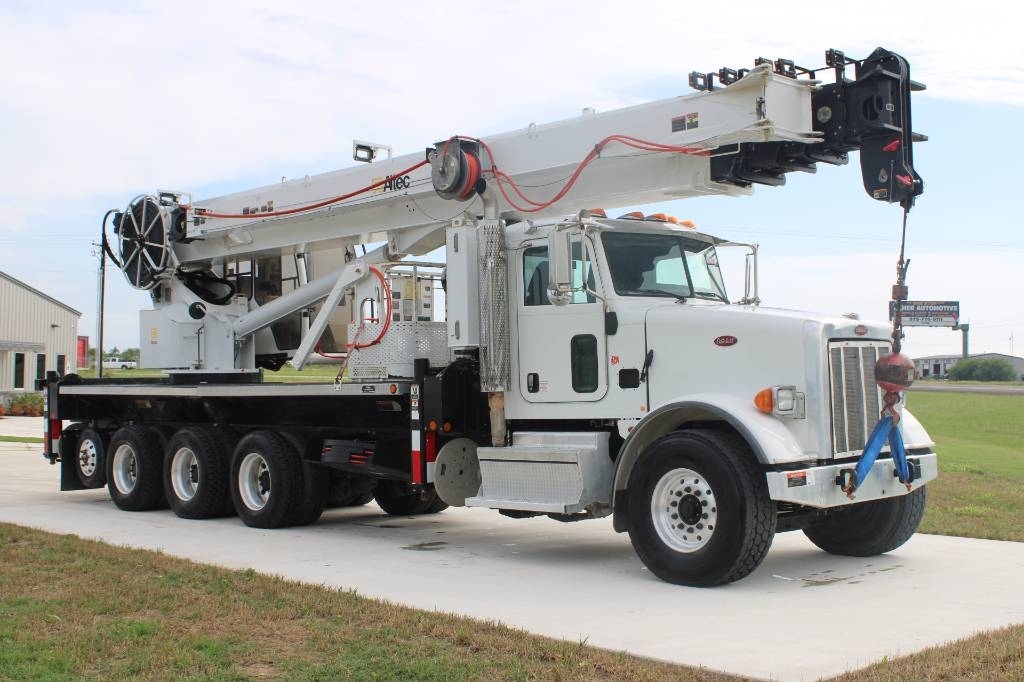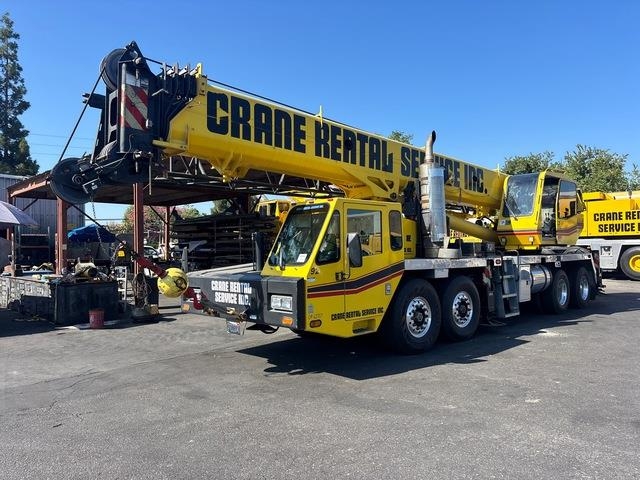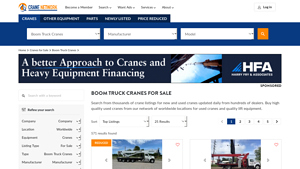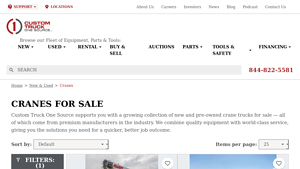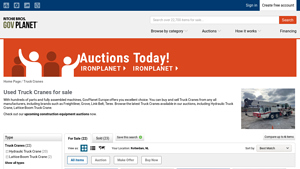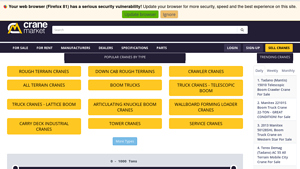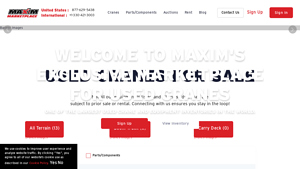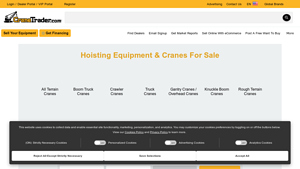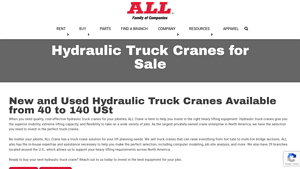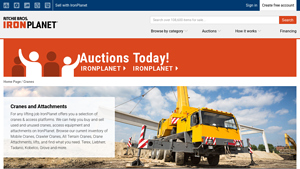Introduction: Navigating the Global Market for truck Cranes For Sale
In the complex landscape of international procurement, sourcing truck cranes for sale can be a daunting task for businesses in diverse markets such as Africa, South America, the Middle East, and Europe. With various types of cranes available—ranging from boom trucks to rough-terrain models—understanding the specific requirements of your projects is crucial. Buyers often face challenges such as identifying reliable suppliers, ensuring compliance with local regulations, and navigating fluctuating prices. This guide aims to demystify the process by providing a comprehensive overview of the truck crane market, including types, applications, supplier vetting techniques, and cost considerations.
Throughout this resource, B2B buyers will gain actionable insights into making informed purchasing decisions. We will explore the distinct advantages of different crane types for various applications, from construction to logistics, while also emphasizing the importance of evaluating supplier credibility and service offerings. Additionally, we will address financing options and maintenance strategies to help maximize your investment’s longevity and efficiency. By empowering international buyers with the knowledge they need, this guide serves as a vital tool for optimizing your procurement strategy in the competitive truck crane market.
Understanding truck Cranes For Sale Types and Variations
| Type Name | Key Distinguishing Features | Primary B2B Applications | Brief Pros & Cons for Buyers |
|---|---|---|---|
| Boom Truck Cranes | Mounted on truck chassis, versatile boom length | Construction, utilities, forestry | Pros: High mobility, quick setup. Cons: Limited lifting capacity compared to larger cranes. |
| Crawler Cranes | Equipped with tracks for stability on uneven terrain | Heavy construction, mining | Pros: Excellent stability, high load capacity. Cons: Less mobile, requires transport for long distances. |
| Rough-Terrain Cranes | Four-wheel drive, designed for off-road conditions | Infrastructure, oil & gas | Pros: Maneuverable in rugged environments. Cons: Higher maintenance costs due to complex systems. |
| Truck-Mounted Cranes | Road-legal, integrated crane and truck design | General lifting and transportation | Pros: Cost-effective for transport and lifting. Cons: Limited to lighter loads compared to specialized cranes. |
| Marine Cranes | Designed for dockside operations, often with specialized features | Shipping, logistics, construction | Pros: Optimized for marine environments, efficient container handling. Cons: Typically more expensive and specialized. |
What are the Characteristics and Suitability of Boom Truck Cranes?
Boom truck cranes are mounted on truck chassis, providing high mobility and versatility. They are ideal for various applications such as construction, utilities, and forestry. These cranes feature extendable booms that allow for flexible lifting capabilities. When purchasing a boom truck crane, B2B buyers should consider the crane’s lifting capacity, boom reach, and the specific needs of their projects, as these factors directly impact operational efficiency.
How Do Crawler Cranes Stand Out in Heavy Applications?
Crawler cranes are characterized by their robust tracks, which provide exceptional stability and load-bearing capacity on uneven terrain. They are commonly used in heavy construction and mining operations where significant lifting power is required. B2B buyers should evaluate the crane’s load capacity and boom length, as these metrics are crucial for large-scale projects. While crawler cranes offer great stability, their lack of mobility means they often require transport for long-distance moves.
What Makes Rough-Terrain Cranes a Good Choice for Challenging Conditions?
Rough-terrain cranes are designed with four-wheel drive, making them well-suited for off-road and rugged environments. They excel in infrastructure projects and oil and gas operations where maneuverability in tough conditions is essential. When considering a rough-terrain crane, B2B buyers should assess the machine’s all-wheel steering capabilities and maintenance requirements, as these factors can influence operational costs and efficiency.
Why Choose Truck-Mounted Cranes for General Lifting?
Truck-mounted cranes combine the features of a crane and a truck, allowing for road-legal transport and efficient lifting. They are widely used for general lifting and transportation tasks, making them a cost-effective option for businesses. Buyers should focus on the crane’s lifting capacity and overall design to ensure it meets the demands of their specific applications. While they are versatile, truck-mounted cranes are generally limited to lighter loads compared to specialized cranes.
What are the Unique Features of Marine Cranes for Dockside Operations?
Marine cranes are specifically designed for operations near docks, equipped with features that facilitate efficient loading and unloading of shipping containers. They are essential in shipping, logistics, and construction projects that involve marine environments. B2B buyers should consider the crane’s lifting capacity, operational range, and specialized features for marine use. While marine cranes provide excellent efficiency, they tend to be more expensive due to their specialized nature and capabilities.
Key Industrial Applications of truck Cranes For Sale
| Industry/Sector | Specific Application of truck Cranes For Sale | Value/Benefit for the Business | Key Sourcing Considerations for this Application |
|---|---|---|---|
| Construction | Lifting and placing heavy materials | Enhances project efficiency and safety on-site | Load capacity, reach, and compliance with local regulations |
| Energy & Utilities | Installation of utility poles and wind turbines | Supports infrastructure development and renewable energy projects | Mobility on rough terrain, stability, and lifting height |
| Transportation & Logistics | Loading and unloading shipping containers | Streamlines operations at ports and distribution centers | Versatility, compatibility with existing fleet, and service support |
| Mining & Quarrying | Transporting equipment and materials | Increases productivity and reduces downtime | Durability, load capacity, and ease of transportation |
| Telecommunications | Erecting communication towers | Facilitates rapid deployment of services in remote areas | Height reach, maneuverability, and support for specialized attachments |
How Are Truck Cranes Used in the Construction Industry?
In the construction sector, truck cranes are essential for lifting and placing heavy materials such as steel beams, precast concrete panels, and large equipment. These cranes enhance project efficiency by allowing for quicker material handling, which is crucial in meeting tight deadlines. Buyers in this sector should consider load capacity and reach, ensuring that the cranes comply with local safety regulations and are suited for the specific site conditions.
What Role Do Truck Cranes Play in Energy & Utilities?
Truck cranes are pivotal in the energy and utilities sector, particularly for installing utility poles and wind turbines. Their ability to operate in diverse terrains makes them suitable for rural and remote locations where infrastructure development is ongoing. When sourcing, buyers should prioritize mobility on rough terrain, stability during operation, and the necessary lifting height to accommodate specific project requirements.
How Do Truck Cranes Enhance Transportation & Logistics Operations?
In the transportation and logistics industry, truck cranes facilitate the loading and unloading of shipping containers at ports and distribution centers. Their versatility allows businesses to streamline operations, significantly reducing turnaround times. Buyers must evaluate compatibility with their existing fleet and ensure that they have adequate service support to minimize downtime during operations.
Why Are Truck Cranes Important in Mining & Quarrying?
In mining and quarrying, truck cranes are used for transporting heavy equipment and materials across challenging sites. Their robust design increases productivity and helps reduce downtime, which is vital in maintaining operational efficiency. Companies should focus on durability, load capacity, and ease of transportation when sourcing cranes for these demanding environments.
How Do Truck Cranes Assist in Telecommunications?
In the telecommunications industry, truck cranes are utilized for erecting communication towers, enabling rapid deployment of services, especially in remote areas. This capability is crucial for enhancing connectivity and service reliability. Buyers should consider height reach, maneuverability, and the ability to support specialized attachments when selecting cranes for these applications.
3 Common User Pain Points for ‘truck Cranes For Sale’ & Their Solutions
Scenario 1: Difficulty in Assessing the Right Crane Specifications
The Problem: Many B2B buyers face challenges in determining the right specifications for truck cranes that suit their operational needs. This often leads to costly mistakes, such as purchasing a crane that cannot handle the required load or lacks the necessary reach for specific projects. Buyers may struggle to interpret technical jargon or compare specifications across different models and manufacturers, which can lead to confusion and frustration.
The Solution: To effectively assess crane specifications, buyers should start by clearly defining their project requirements, including load capacities, boom lengths, and operating environments. Utilizing detailed comparison charts available on reputable crane sales websites can help buyers visualize differences between models. Additionally, engaging with knowledgeable sales representatives who can provide tailored advice based on specific project needs is crucial. For complex projects, consulting with an engineer or equipment specialist can ensure that the chosen crane meets all operational demands and safety standards. Buyers should also consider future needs, ensuring that the crane’s specifications allow for versatility across various projects.
Scenario 2: Navigating the Used Crane Market
The Problem: Purchasing used truck cranes can be daunting for international buyers, particularly in regions like Africa and South America, where market knowledge may be limited. Buyers often worry about the condition, reliability, and potential hidden costs associated with used equipment. They may fear investing in a crane that is not only subpar but may also lead to increased maintenance and operational downtime.
The Solution: To navigate the used crane market effectively, buyers should prioritize sourcing from reputable dealers with a solid track record in the industry. It’s advisable to request detailed inspection reports and maintenance histories for any used crane being considered. Buyers should also seek warranties or service agreements that can mitigate risks associated with potential issues post-purchase. Additionally, conducting a thorough pre-purchase inspection—ideally with the assistance of a third-party expert—can provide invaluable insights into the crane’s condition. Building relationships with local dealers or industry contacts can also enhance the buyer’s understanding of the local market and available options.
Scenario 3: Understanding Financing Options for Crane Purchases
The Problem: Many businesses find financing options for truck cranes complex and overwhelming. International buyers, in particular, may encounter unique challenges related to currency fluctuations, differing financial regulations, and a lack of clarity regarding lease versus purchase decisions. This complexity can lead to indecision, missed opportunities, and financial strain.
The Solution: To simplify the financing process, buyers should first conduct thorough research on available options tailored to their specific needs. This includes exploring in-house financing plans offered by crane dealers, which often come with flexible terms that can ease cash flow concerns. Buyers should also consider the total cost of ownership, including maintenance, insurance, and operational costs, when making financing decisions. Consulting with financial advisors who specialize in heavy equipment can provide additional insights and help buyers weigh the benefits of purchasing versus leasing based on their unique operational contexts. Finally, establishing a clear budget and understanding the long-term financial implications of the purchase can guide buyers toward the most beneficial financing solution.
Strategic Material Selection Guide for truck Cranes For Sale
When selecting materials for truck cranes, it is crucial to consider their properties, pros and cons, and how they align with specific applications. This analysis focuses on four common materials used in truck cranes: steel, aluminum, composite materials, and high-strength alloys. Each material has unique characteristics that can significantly impact performance, durability, and cost.
What Are the Key Properties of Steel for Truck Cranes?
Steel is the most widely used material in truck crane construction due to its excellent strength and durability. It typically has a high tensile strength, allowing it to withstand significant loads and stresses. Steel also exhibits good temperature resistance, making it suitable for various environmental conditions. However, it is susceptible to corrosion, especially in humid or saline environments, which can be a concern for international buyers in coastal regions.
Pros and Cons of Steel:
– Pros: High strength-to-weight ratio, excellent load-bearing capacity, and availability.
– Cons: Heavier than alternatives, requires protective coatings to prevent rust, and can be more expensive to transport due to weight.
How Does Aluminum Compare as a Material for Truck Cranes?
Aluminum is increasingly used in truck cranes due to its lightweight properties, which enhance fuel efficiency and ease of transport. It has good corrosion resistance, making it ideal for applications in coastal or humid environments. However, aluminum’s tensile strength is lower than that of steel, which may limit its use in heavy-duty applications.
Pros and Cons of Aluminum:
– Pros: Lightweight, good corrosion resistance, and lower transportation costs.
– Cons: Lower strength compared to steel, higher cost per unit weight, and potential for fatigue failure under cyclic loading.
What Role Do Composite Materials Play in Truck Crane Construction?
Composite materials, such as fiberglass and carbon fiber, are gaining traction in truck crane design due to their high strength-to-weight ratios and excellent corrosion resistance. These materials can be tailored for specific applications, providing flexibility in design. However, they are often more expensive and may require specialized manufacturing processes.
Pros and Cons of Composite Materials:
– Pros: Lightweight, customizable, and resistant to corrosion and chemicals.
– Cons: Higher manufacturing complexity, limited availability, and higher initial costs.
Why Are High-Strength Alloys Important for Truck Cranes?
High-strength alloys, often used in critical components of truck cranes, offer enhanced performance in demanding applications. These materials can withstand higher loads and resist deformation better than standard materials. However, they can be cost-prohibitive and may require specialized fabrication techniques.
Pros and Cons of High-Strength Alloys:
– Pros: Superior strength and durability, reduced weight for specific applications, and resistance to wear and fatigue.
– Cons: High cost, complex manufacturing processes, and potential for brittleness under certain conditions.
What Should International Buyers Consider When Selecting Materials?
International buyers from regions like Africa, South America, the Middle East, and Europe need to consider local regulations and standards when selecting materials for truck cranes. Compliance with standards such as ASTM (American Society for Testing and Materials), DIN (Deutsches Institut für Normung), or JIS (Japanese Industrial Standards) is essential. Additionally, understanding the local climate and environmental conditions can help in selecting the most suitable materials.
| Material | Typical Use Case for truck Cranes For Sale | Key Advantage | Key Disadvantage/Limitation | Relative Cost (Low/Med/High) |
|---|---|---|---|---|
| Steel | Structural components and boom arms | High strength and durability | Heavier, prone to corrosion | Medium |
| Aluminum | Lightweight cranes for urban environments | Lightweight, good corrosion resistance | Lower strength, higher cost | High |
| Composite Materials | Specialized applications and components | Lightweight, customizable | High cost, complex manufacturing | High |
| High-Strength Alloys | Critical load-bearing components | Superior strength and durability | High cost, potential brittleness | High |
This strategic material selection guide provides a comprehensive overview for B2B buyers, enabling informed decisions that align with operational requirements and local conditions.
In-depth Look: Manufacturing Processes and Quality Assurance for truck Cranes For Sale
What Are the Key Stages in the Manufacturing Process of Truck Cranes?
The manufacturing process of truck cranes is a complex operation that involves several critical stages, each contributing to the final product’s quality, performance, and safety. Understanding these stages can help B2B buyers make informed purchasing decisions.
1. Material Preparation
The first step in manufacturing truck cranes is the selection and preparation of raw materials. High-strength steel is commonly used for the structural components due to its durability and ability to withstand heavy loads. The material is typically cut into specific shapes using advanced technologies like laser cutting or plasma cutting. This precision ensures that the components fit together seamlessly during assembly.
2. Forming and Fabrication
Following material preparation, the forming stage involves shaping the components through various methods such as bending, welding, and machining. Techniques like hot forming or cold forming may be employed depending on the material properties required. For truck cranes, components like the boom, chassis, and stabilizers undergo rigorous fabrication processes to enhance their structural integrity and load-bearing capabilities.
3. Assembly
The assembly stage is where individual parts come together to form the truck crane. This stage requires skilled labor and precise engineering to ensure that all components are installed correctly. The assembly process typically includes installing hydraulic systems, electrical wiring, and safety features. Quality control measures are integrated at this stage to detect any assembly errors before the crane moves to the next phase.
4. Finishing
The finishing stage is crucial for enhancing the crane’s durability and aesthetics. This typically involves surface treatments such as painting, galvanizing, or powder coating to protect against corrosion and environmental wear. The finishing process not only contributes to the crane’s longevity but also impacts its resale value, which is a vital consideration for international buyers.
How is Quality Assurance Implemented in Truck Crane Manufacturing?
Quality assurance (QA) is integral to the manufacturing process, ensuring that each truck crane meets stringent safety and performance standards. The following outlines the QA protocols typically employed in the industry.
International Standards and Certifications
Manufacturers often adhere to international standards such as ISO 9001, which focuses on quality management systems. This certification indicates that the manufacturer has established effective processes for maintaining quality throughout production. Additionally, industry-specific certifications, such as CE marking in Europe and API (American Petroleum Institute) standards, are crucial for demonstrating compliance with safety and performance requirements.
What Are the Key Quality Control Checkpoints?
Quality control (QC) involves multiple checkpoints throughout the manufacturing process:
-
Incoming Quality Control (IQC): At this stage, raw materials are inspected for compliance with specifications before they are used in production. This step is vital for preventing defects in the final product.
-
In-Process Quality Control (IPQC): This involves monitoring the manufacturing process itself. Technicians conduct regular inspections and tests to ensure that assembly and fabrication meet the required standards.
-
Final Quality Control (FQC): After assembly, the crane undergoes a thorough inspection and testing phase. This includes load testing, operational checks, and verification of safety features to ensure the crane performs as expected.
What Testing Methods Are Commonly Used in Truck Crane Manufacturing?
Testing methods are essential for verifying the functionality and safety of truck cranes. Common methods include:
-
Load Testing: This involves applying loads greater than the crane’s maximum rated capacity to ensure stability and performance under extreme conditions.
-
Functional Testing: Technicians evaluate all operational aspects, including hydraulic systems, controls, and safety mechanisms, to ensure they function correctly.
-
Non-Destructive Testing (NDT): Techniques such as ultrasonic or magnetic particle inspection are employed to detect internal flaws in welded joints and structural components without damaging them.
How Can B2B Buyers Verify Supplier Quality Control?
For international buyers, particularly those from regions like Africa, South America, the Middle East, and Europe, verifying a supplier’s quality control processes is crucial. Here are several strategies:
-
Supplier Audits: Conducting on-site audits allows buyers to evaluate the manufacturer’s facilities, processes, and compliance with quality standards. This hands-on approach can reveal insights into the supplier’s commitment to quality.
-
Requesting Quality Reports: Buyers should ask for quality assurance documentation, including inspection reports, testing certificates, and compliance records. These documents provide transparency regarding the manufacturing process and product quality.
-
Third-Party Inspections: Engaging third-party inspection services can offer an unbiased assessment of the crane’s quality before purchase. This is especially valuable for buyers unfamiliar with local manufacturing standards.
What Are the Quality Control Nuances for International Buyers?
When dealing with international suppliers, particularly in diverse regions, buyers must navigate various nuances:
-
Understanding Local Standards: Each country may have different safety and quality regulations. B2B buyers should familiarize themselves with these standards to ensure compliance.
-
Language Barriers: Communication can pose challenges. Buyers should ensure that all quality documentation is available in a language they understand, facilitating better comprehension of the product specifications and compliance requirements.
-
Cultural Differences: Building strong relationships with suppliers can significantly impact quality assurance. Understanding cultural norms and business practices in the supplier’s region can enhance collaboration and trust.
Conclusion
Understanding the manufacturing processes and quality assurance practices for truck cranes is essential for B2B buyers seeking reliable equipment. By being informed about the stages of production, quality control measures, and verification methods, buyers can make educated decisions that align with their operational needs and compliance requirements. This knowledge not only mitigates risks but also ensures that the investment in truck cranes yields optimal performance and safety in the field.
Practical Sourcing Guide: A Step-by-Step Checklist for ‘truck Cranes For Sale’
This guide is designed to assist B2B buyers in navigating the procurement process for truck cranes, ensuring that critical aspects are considered to achieve successful acquisition and investment. With the right approach, you can streamline your sourcing efforts and secure the most suitable equipment for your business needs.
Step 1: Define Your Technical Specifications
Begin by outlining your specific requirements for the truck crane. This includes load capacity, boom length, and operational features. Understanding your technical needs is crucial as it helps narrow down options and ensures you select a crane that can handle your intended tasks effectively.
- Load Capacity: Determine the maximum weight the crane must lift.
- Boom Type: Decide if you need a telescopic or articulating boom based on your work environment.
Step 2: Research the Market
Conduct thorough market research to identify available models and manufacturers that meet your specifications. This step helps in understanding the range of options and price points, enabling informed decision-making.
- Local and International Suppliers: Consider both local suppliers for immediate support and international ones for a broader selection.
- Trends and Innovations: Keep an eye on industry trends to ensure you are aware of the latest technology and equipment advancements.
Step 3: Evaluate Potential Suppliers
Before making a purchase, it’s essential to vet potential suppliers thoroughly. A well-established supplier can provide assurance of quality and reliability.
- Company Reputation: Look for reviews and testimonials from other customers.
- Certifications and Compliance: Ensure that the supplier adheres to industry standards and regulations, which can affect the crane’s performance and safety.
Step 4: Inspect Equipment Condition
For used truck cranes, inspecting the equipment’s condition is vital to avoid costly repairs later. A physical inspection can reveal issues that might not be apparent in online listings.
- Wear and Tear: Check for signs of wear on critical components like the boom and hydraulic systems.
- Service History: Request maintenance records to understand the crane’s operational history.
Step 5: Assess Financing and Warranty Options
Understanding your financing options and warranty coverage can significantly impact your purchasing decision. Different suppliers may offer various financing solutions that can help with cash flow management.
- Flexible Payment Plans: Look for suppliers that offer in-house financing or leasing options.
- Warranty Coverage: A solid warranty can provide peace of mind and protect your investment against unforeseen issues.
Step 6: Negotiate Terms and Finalize Purchase
Once you have selected a supplier and equipment, negotiate the terms of the sale. This includes price, delivery timelines, and any after-sales support that may be included.
- Total Cost of Ownership: Consider not just the purchase price but also potential maintenance and operational costs.
- Delivery and Setup: Ensure clarity on delivery responsibilities and setup requirements to avoid delays.
Step 7: Plan for Training and Integration
After acquiring your truck crane, plan for operator training and equipment integration into your operations. Proper training ensures safety and maximizes the crane’s efficiency.
- Operator Training: Invest in training programs to ensure operators are proficient in using the equipment.
- Maintenance Schedule: Establish a routine maintenance schedule to prolong the crane’s lifespan and enhance reliability.
By following this checklist, B2B buyers can approach the procurement of truck cranes methodically, ensuring that their investment is sound and meets their operational needs effectively.
Comprehensive Cost and Pricing Analysis for truck Cranes For Sale Sourcing
What Are the Key Cost Components in Truck Cranes for Sale?
When sourcing truck cranes for sale, understanding the underlying cost structure is essential for effective budgeting and procurement. The primary cost components include materials, labor, manufacturing overhead, tooling, quality control (QC), logistics, and supplier margin.
-
Materials: The raw materials used in crane manufacturing, such as steel and hydraulic components, significantly influence costs. High-quality materials enhance durability and operational efficiency, but they also increase the initial purchase price.
-
Labor: Labor costs encompass wages for skilled technicians and assembly line workers involved in crane production. Regions with higher labor costs, such as Europe, may see elevated prices compared to those in emerging markets.
-
Manufacturing Overhead: This includes expenses related to factory operations, such as utilities, depreciation of equipment, and facility maintenance. Efficient manufacturing processes can help mitigate these costs.
-
Tooling: Specialized tools and machinery required for crane production contribute to the overall cost. Investments in advanced technology can enhance production efficiency but may require higher upfront costs.
-
Quality Control (QC): Rigorous QC processes ensure that cranes meet safety and performance standards. While these processes may add to the cost, they are crucial for reducing warranty claims and enhancing customer satisfaction.
-
Logistics: Transportation costs for delivering cranes to buyers can vary significantly based on distance, shipping method, and local regulations. International shipping may involve additional costs, such as customs duties and insurance.
-
Margin: Suppliers typically add a profit margin on top of their production costs. This margin can vary based on market demand, brand reputation, and competitive landscape.
How Do Price Influencers Impact Truck Crane Sourcing?
Several factors influence the pricing of truck cranes, making it essential for buyers to consider these variables during procurement.
-
Volume and Minimum Order Quantity (MOQ): Purchasing in larger volumes can lead to significant discounts. Suppliers are often willing to negotiate pricing for bulk orders, making this an effective strategy for cost savings.
-
Specifications and Customization: Custom-built cranes tailored to specific requirements may incur additional costs. Buyers should assess whether these customizations are necessary for their operations.
-
Materials and Quality Certifications: The choice of materials and the presence of quality certifications can greatly impact the price. Cranes with higher safety ratings and certifications may command higher prices but provide better long-term value.
-
Supplier Factors: The reputation and reliability of the supplier can influence pricing. Established suppliers with a proven track record may charge more but offer better service and support.
-
Incoterms: Understanding shipping terms (Incoterms) is vital for international buyers. These terms dictate the responsibilities of buyers and sellers in terms of shipping costs, insurance, and risk, affecting the overall cost of the crane.
What Buyer Tips Can Help Achieve Cost Efficiency in Crane Sourcing?
B2B buyers, particularly from regions like Africa, South America, the Middle East, and Europe, can leverage several strategies to enhance cost-efficiency in their crane sourcing:
-
Negotiation: Engage in proactive negotiations with suppliers to secure better pricing or favorable payment terms. Building long-term relationships can also lead to future discounts.
-
Total Cost of Ownership (TCO): Evaluate the TCO rather than just the initial purchase price. Consider maintenance, operational costs, and potential resale value when making purchasing decisions.
-
Research Pricing Nuances for International Sourcing: Be aware of the pricing differences based on regional markets. For instance, cranes sourced from Europe may be more expensive than those from Asia due to labor and material costs. Understanding these nuances can help buyers make informed decisions.
-
Seek Multiple Quotes: Obtaining quotes from various suppliers can provide insight into market pricing and help identify competitive offers.
-
Consider Used or Refurbished Options: Investigating the market for quality used or refurbished cranes can yield significant savings while still meeting operational needs.
Disclaimer on Indicative Prices
Prices for truck cranes can vary widely based on specifications, condition (new vs. used), and market dynamics. The figures provided in listings are indicative and should not be taken as final quotes. Always consult with suppliers for the most accurate pricing tailored to your specific requirements.
Alternatives Analysis: Comparing truck Cranes For Sale With Other Solutions
Introduction: Exploring Alternative Solutions to Truck Cranes
When considering equipment for heavy lifting and transportation, B2B buyers often evaluate various options to determine the best fit for their operational needs. Truck cranes are a popular choice due to their versatility and ease of transport. However, alternatives such as crawler cranes and rough-terrain cranes may also meet specific project requirements. In this analysis, we will compare truck cranes for sale against these two alternatives, allowing buyers to make informed decisions based on performance, cost, ease of implementation, maintenance, and best use cases.
Comparison Table
| Comparison Aspect | Truck Cranes For Sale | Crawler Cranes | Rough-Terrain Cranes |
|---|---|---|---|
| Performance | Ideal for lighter loads and urban settings | High load capacities; stable on uneven terrain | Good for off-road applications; versatile |
| Cost | Generally moderate to high; used options available | Higher upfront costs; lower long-term maintenance | Moderate; may vary based on terrain capability |
| Ease of Implementation | Quick setup and transportation on roads | Requires more setup time; not road-legal | Easy to transport but needs skilled operators |
| Maintenance | Standard maintenance; parts readily available | Higher maintenance needs due to complexity | Moderate; requires specialized parts and service |
| Best Use Case | Urban construction, utility work | Heavy lifting in construction, mining | Construction in rough, off-road terrains |
Detailed Breakdown of Alternatives
Crawler Cranes: Are They Worth the Investment?
Crawler cranes are designed for stability and high lifting capacity, making them suitable for heavy construction and mining projects. Their tracks allow them to navigate uneven terrain effectively, providing a reliable solution for jobs that require extensive lifting capabilities. However, their higher upfront costs and complex maintenance requirements can be a drawback. They are not road-legal, which means additional transportation logistics must be considered when moving to different job sites.
Rough-Terrain Cranes: Versatility in Challenging Conditions
Rough-terrain cranes are built to handle off-road conditions, featuring all-wheel drive and exceptional maneuverability. They excel in construction projects that occur in rugged environments, such as oil fields or mountainous areas. The initial investment is moderate, and they are easier to transport than crawler cranes, but they also require skilled operators to maximize their efficiency. While they can manage various lifting tasks, their capabilities may be limited compared to crawler cranes in terms of load capacity.
Conclusion: How to Choose the Right Solution for Your Needs
Selecting the right equipment for heavy lifting is crucial for optimizing productivity and ensuring project success. B2B buyers should assess their specific operational needs, including the type of terrain, load requirements, and budget constraints. While truck cranes for sale offer convenience and suitability for urban environments, alternatives like crawler and rough-terrain cranes provide unique benefits that may be more appropriate for specific applications. By carefully weighing the pros and cons of each option, businesses can make informed decisions that align with their project goals and operational efficiencies.
Essential Technical Properties and Trade Terminology for truck Cranes For Sale
What Are the Key Technical Properties of Truck Cranes for Sale?
When evaluating truck cranes for purchase, understanding their technical properties is crucial for making an informed investment. Here are some essential specifications that B2B buyers should consider:
-
Load Capacity (Tons)
The load capacity indicates the maximum weight a crane can lift safely. This specification is critical as it directly affects the crane’s application in various industries, such as construction, logistics, and heavy equipment handling. Buyers should assess their lifting needs to ensure the crane can handle the intended loads without compromising safety. -
Boom Length
The boom length refers to the extendable arm of the crane that allows it to reach upward and outward. A longer boom enhances versatility, enabling the crane to operate in confined spaces or over obstacles. Understanding boom length is vital for projects requiring significant reach, especially in urban environments or construction sites with height restrictions. -
Stability Rating
Stability is often measured through a crane’s outrigger spread and its center of gravity. A crane with a higher stability rating can operate safely on uneven terrain and in various weather conditions. For international buyers, particularly in regions with diverse topographies, selecting a crane with robust stability ensures safer operations and minimizes the risk of accidents. -
Engine Power and Type
The engine power (measured in horsepower) influences the crane’s performance, especially in terms of speed and efficiency. Additionally, the type of engine—diesel or electric—affects fuel consumption and operating costs. Buyers should consider their operational environment when selecting engine specifications, as certain engines perform better in specific settings. -
Transportation Dimensions
The overall dimensions of the crane, including height, width, and weight, are crucial for transportation logistics. Understanding these specifications helps buyers plan for road transport and ensure compliance with local regulations, especially in regions with strict vehicle size limitations. -
Hydraulic System Specifications
The hydraulic system is integral to a crane’s lifting capabilities. Key specifications include the type of hydraulic fluid used and the system’s pressure rating. A well-designed hydraulic system enhances lifting speed and precision, which are essential for time-sensitive projects.
What Are Common Trade Terminologies Used in the Truck Crane Industry?
Familiarity with industry jargon can significantly enhance communication and decision-making in B2B transactions. Here are some essential terms relevant to truck cranes:
-
OEM (Original Equipment Manufacturer)
This term refers to companies that produce equipment that may be marketed by another company. Understanding OEM specifications helps buyers ensure they are acquiring quality parts and service, which is crucial for maintaining crane performance and reliability. -
MOQ (Minimum Order Quantity)
MOQ indicates the smallest quantity of a product that a supplier is willing to sell. This term is essential for international buyers looking to optimize inventory costs and manage budgets effectively. Knowing the MOQ helps in planning purchases and negotiating better terms with suppliers. -
RFQ (Request for Quotation)
An RFQ is a formal process where buyers invite suppliers to bid on specific products or services. This term is vital for B2B transactions, as it helps in obtaining competitive pricing and terms, ensuring that buyers can make cost-effective decisions. -
Incoterms (International Commercial Terms)
Incoterms are a set of international rules that define the responsibilities of buyers and sellers in global transactions. Understanding these terms is crucial for buyers engaged in international trade, as they clarify shipping responsibilities, risks, and costs. -
Warranty and Service Agreements
Warranty terms outline the manufacturer’s commitment to repair or replace defective parts within a specified period. Service agreements often provide ongoing maintenance and support. Knowing these terms helps buyers assess the long-term value and support available for their investment. -
Load Chart
A load chart is a graphical representation that details the lifting capacity of a crane at various boom lengths and angles. This tool is essential for operators to ensure safe lifting practices and to maximize crane utility.
By understanding these technical properties and trade terminologies, international B2B buyers can make informed decisions when purchasing truck cranes, ensuring they meet their operational needs while adhering to safety and compliance standards.
Navigating Market Dynamics and Sourcing Trends in the truck Cranes For Sale Sector
What Are the Key Market Dynamics Driving the Truck Cranes For Sale Sector?
The global truck cranes market is witnessing a surge fueled by infrastructure development and urbanization, especially in emerging economies across Africa, South America, the Middle East, and parts of Europe like Germany and Vietnam. Key drivers include the rising demand for efficient lifting solutions in construction, logistics, and oil and gas sectors. Furthermore, technological advancements are reshaping how cranes are sourced and utilized. The integration of telematics and IoT (Internet of Things) allows for real-time monitoring and predictive maintenance, enhancing operational efficiency and reducing downtime.
As international B2B buyers navigate this landscape, they are increasingly prioritizing suppliers that offer not just equipment but comprehensive service packages, including financing options and post-purchase support. The trend toward digital platforms for sourcing cranes is also on the rise. Buyers can now access vast inventories, compare prices, and evaluate equipment conditions without geographical constraints, leading to more informed purchasing decisions.
Another emerging trend is the growing emphasis on used truck cranes. With the high cost of new equipment, many companies are opting for certified pre-owned cranes, which offer significant savings while still meeting operational needs. This shift is particularly pronounced in developing regions, where budget constraints are a primary concern.
How Is Sustainability and Ethical Sourcing Influencing the Truck Cranes Market?
Sustainability is becoming a pivotal consideration for international B2B buyers in the truck cranes sector. The environmental impact of heavy machinery is under scrutiny, prompting companies to seek equipment that adheres to eco-friendly standards. Ethical sourcing practices are gaining traction, as buyers increasingly demand transparency in supply chains.
The importance of using ‘green’ materials and technologies is paramount. Manufacturers are responding by incorporating energy-efficient engines and recyclable materials in their cranes. Certifications such as ISO 14001, which focuses on effective environmental management systems, are becoming essential for suppliers to demonstrate their commitment to sustainability.
Moreover, the push for reducing carbon footprints is influencing procurement strategies. Buyers are looking for suppliers who can provide detailed reports on emissions and lifecycle impacts of their products. This shift towards sustainability not only helps in compliance with stricter regulations but also enhances brand reputation among environmentally conscious consumers.
What Is the Historical Context of the Truck Cranes Market?
The truck cranes sector has evolved significantly over the past few decades. Initially dominated by mechanical systems, the market has transitioned towards hydraulic and computerized systems, greatly enhancing lifting capabilities and operational efficiency.
The late 20th century marked the introduction of specialized truck cranes designed for specific applications, such as urban construction and logistics. This evolution has been driven by increasing project complexities and the need for versatile lifting solutions. Today, the market is characterized by a blend of innovation and reliability, with manufacturers focusing on both new technologies and the refurbishment of existing equipment to meet the diverse needs of international buyers.
As the sector continues to grow, understanding these dynamics and sourcing trends will be crucial for B2B buyers aiming to make informed, strategic purchasing decisions.
Frequently Asked Questions (FAQs) for B2B Buyers of truck Cranes For Sale
-
How do I choose the right truck crane for my business needs?
Selecting the right truck crane involves assessing your operational requirements, including load capacity, reach, and mobility. Consider the types of projects you undertake and the terrain you typically work in. Review the specifications of various models, including their lifting capabilities and features like hydraulic systems. Additionally, consult with suppliers to understand which cranes are best suited for your specific applications, ensuring they align with your industry standards and regulations. -
What factors should I consider when importing truck cranes internationally?
When importing truck cranes, it’s crucial to evaluate customs regulations, import duties, and compliance with local safety standards. Research the documentation required for international trade, such as bills of lading and import permits. Additionally, consider the supplier’s reliability and reputation in the market, as well as logistics options for shipping and delivery. Establishing strong communication with your supplier will help navigate potential hurdles during the import process. -
What are the typical payment terms for purchasing truck cranes?
Payment terms can vary significantly depending on the supplier and the scale of the purchase. Common arrangements include upfront payments, financing options, or installment plans. Some suppliers may offer leasing options, allowing you to acquire equipment without a large initial outlay. Always clarify the payment schedule, acceptable payment methods, and any penalties for late payments before finalizing the transaction to avoid misunderstandings. -
How can I ensure the quality of used truck cranes before purchase?
To ensure the quality of used truck cranes, conduct a thorough inspection of the equipment, including its mechanical and structural integrity. Request maintenance records and service history to understand how well the crane has been maintained. If possible, arrange for a third-party inspection or certification to verify the crane’s condition. Additionally, inquire about warranties or guarantees provided by the seller to protect your investment. -
What is the process for customizing truck cranes to meet specific operational needs?
Customization options for truck cranes can vary widely among manufacturers. Discuss your specific requirements with the supplier, including modifications for load capacity, boom length, or specialized attachments. Many suppliers offer tailored solutions to enhance functionality for unique job sites. Be sure to clarify lead times for customization and any additional costs associated with the modifications to ensure they fit within your budget and project timelines. -
What are the minimum order quantities (MOQ) for purchasing truck cranes?
Minimum order quantities can differ based on the supplier and the type of crane being purchased. Some suppliers may allow for single-unit purchases, especially for used cranes, while others may require bulk orders for new models. It’s essential to communicate your needs upfront to determine the most suitable purchasing options. If your volume is lower than the MOQ, consider negotiating with the supplier or exploring group purchasing arrangements with other businesses. -
How do I vet suppliers when sourcing truck cranes internationally?
Vetting suppliers involves several key steps: conducting background research, reviewing customer testimonials, and checking for certifications and industry affiliations. Engage with previous clients to gather insights into their experiences with the supplier. Additionally, assess the supplier’s financial stability and capacity to fulfill your orders in a timely manner. Utilize platforms such as trade shows or industry associations to connect with reputable suppliers and verify their credibility. -
What logistical considerations should I keep in mind when purchasing truck cranes?
Logistical considerations include transportation methods, delivery timelines, and potential import/export challenges. Ensure that your supplier can accommodate the transportation of heavy equipment and understands the regulations for moving cranes across borders. Discuss shipping options, including freight forwarding and customs clearance processes. Furthermore, plan for potential delays and establish a clear communication channel with your supplier to track the shipment’s progress effectively.
Important Disclaimer & Terms of Use
⚠️ Important Disclaimer
The information provided in this guide, including content regarding manufacturers, technical specifications, and market analysis, is for informational and educational purposes only. It does not constitute professional procurement advice, financial advice, or legal advice.
While we have made every effort to ensure the accuracy and timeliness of the information, we are not responsible for any errors, omissions, or outdated information. Market conditions, company details, and technical standards are subject to change.
B2B buyers must conduct their own independent and thorough due diligence before making any purchasing decisions. This includes contacting suppliers directly, verifying certifications, requesting samples, and seeking professional consultation. The risk of relying on any information in this guide is borne solely by the reader.
Top 8 Truck Cranes For Sale Manufacturers & Suppliers List
1. Manitex – TC50155HL
Domain: cranenetwork.com
Registered: 2000 (25 years)
Introduction: {“cranes_for_sale”: [{“year”: 2023, “manufacturer”: “Manitex”, “model”: “TC50155HL”, “price”: “$565,000”, “monthly_estimate”: “$10,068”}, {“year”: 2000, “manufacturer”: “Terex”, “model”: “BT 3470”, “price”: “$36,000”, “monthly_estimate”: “$641”}, {“year”: 2006, “manufacturer”: “Terex”, “model”: “4792”, “price”: “$79,900”, “monthly_estimate”: “$1,423”}, {“year”: 2002, “manufacturer”: “National”, “m…
2. Custom Truck One Source – Cranes
Domain: customtruck.com
Registered: 1996 (29 years)
Introduction: Custom Truck One Source offers a variety of new and used cranes for sale, including: Crawler cranes, Rough-terrain cranes, Truck cranes, Boom trucks, and Marine terminal cranes. The cranes are sourced from premium manufacturers such as Freightliner, Elliott, Ford, Kenworth, Mantis, Peterbilt, Western Star, and PowerTraxx. Key features include impressive load capacities, stability on uneven ground,…
3. Truck Cranes – Hydraulic & Lattice-Boom
Domain: govplanet.com
Registered: 2007 (18 years)
Introduction: Truck Cranes for sale on GovPlanet include various types such as Hydraulic Truck Cranes and Lattice-Boom Truck Cranes. The available brands include Freightliner, Grove, Link-Belt, and Terex. There are 22 truck cranes listed for sale, with options for auction formats including online and sealed auctions, as well as ‘Buy Now’ and ‘Make Offer’ options. The cranes range in price from $5,000 to $499,99…
4. CraneMarket – Cranes for Sale and Rent
Domain: cranemarket.com
Registered: 2009 (16 years)
Introduction: Cranes for Sale and Rent | Used and New Cranes | CraneMarket.com
Popular cranes by type:
– Rough Terrain Cranes
– Down Cab Rough Terrains
– Crawler Cranes
– All Terrain Cranes
– Boom Trucks
– Truck Cranes – Telescopic
– Truck Cranes – Lattice
– Boom Lifts – Articulating
– Boom Lifts – Telescopic
– Aerial Platforms
– Derrick Cranes
– Tower Cranes
– Industrial Cranes
– Service Cranes
Latest Listin…
5. Maxim – Used Cranes Marketplace
Domain: marketplace.maximcrane.com
Registered: 2000 (25 years)
Introduction: This company, Maxim – Used Cranes Marketplace, is a notable entity in the market. For specific product details, it is recommended to visit their website directly.
6. Cranetrader – Cranes for Sale
Domain: cranetrader.com
Registered: 2000 (25 years)
Introduction: Cranes for sale: New & Used. Types of cranes available include All Terrain Cranes, Boom Truck Cranes, Crawler Cranes, Truck Cranes, Gantry Cranes, Knuckle Boom Cranes, Rough Terrain Cranes, Bucket Trucks, Carry Deck Cranes, Tower Cranes, Digger Derricks, Mini Cranes, and Specialized Application Cranes. Popular brands include Link-Belt, Liebherr, Manitowoc, Grove, Terex, and XCMG. The site features…
7. ALL Crane – Hydraulic Truck Cranes
Domain: allcrane.com
Registered: 1997 (28 years)
Introduction: Hydraulic Truck Cranes for Sale: New and Used available from 40 to 140 USt. Superior mobility, extreme lifting capacity, and flexibility for various jobs. ALL Crane offers in-house expertise, including computer modeling and job site analysis. 29 branches across the U.S. for support. Rental Purchase Options available to try before you buy. Financing options to simplify the process. Specialized tran…
8. IronPlanet – Cranes for Sale
Domain: ironplanet.com
Registered: 1999 (26 years)
Introduction: Cranes for sale include various types such as All Terrain Cranes, Boom Trucks, Carry Deck and Pick-and-Carry Cranes, Compact Cranes, Crane Attachments, Crawler Cranes, Overhead Cranes, Rough Terrain Cranes, Tower Cranes, and Truck Cranes. Popular makes include Grove, International, Landhonor, Link-Belt, Manitowoc, and Suihe. IronPlanet offers hundreds of used mobile cranes, crawler cranes, and all…
Strategic Sourcing Conclusion and Outlook for truck Cranes For Sale
In conclusion, effective strategic sourcing of truck cranes is vital for businesses seeking to enhance operational efficiency and maximize return on investment. By leveraging a diverse range of suppliers and understanding market dynamics, buyers can identify high-quality equipment that meets their specific needs while ensuring competitive pricing.
International buyers, particularly in regions like Africa, South America, the Middle East, and Europe, should prioritize the evaluation of both new and used crane options. This includes assessing factors such as manufacturer reputation, equipment condition, and total cost of ownership. As the demand for reliable lifting solutions grows, the ability to source the right equipment will directly impact project success and profitability.
Looking ahead, it is crucial for businesses to stay abreast of emerging trends and technologies within the crane industry. Engaging with reputable suppliers and participating in industry forums can provide valuable insights and foster beneficial partnerships. Now is the time to act—explore your options for truck cranes today and position your business for future growth and success in an increasingly competitive landscape.

